Abstract
University and industry goals can complement each other. Thus, there is considerable advantage to a university-industry partnership, especially in applied geophysics. This article discusses a consortium model for the collaboration and provides an example – the CREWES Project at the University of Calgary. The mandate of the CREWES Project is to make better subsurface pictures to assist in resource discovery and recovery, and environmental mitigation while educating students and advancing geoscience. To make a consortium work, there need to be natural advantages, ongoing demand, and demonstrated productivity. By effective use of opportunities and advantages, consortia can p rovide well educated personnel, economically useful output, and scientific achievements.
Introduction
A broad societal goal is to have a prosperous economy (providing interesting and profitable employment) that supports healthy social circumstances. Economies and societies function by supplying services and goods to their populaces. Education is naturally required to train individuals to participate in these social and economic structures. Increased educational attainment is also socially desirable because it is associated with lower rates of unemployment, higher incomes (and higher tax revenues), better health outcomes, lower social welfare spending, and reduced likelihood of following-generation poverty (CalFASA, 2004). For example, the Association of Professional Engineers, Geologists, and Geophysicists of Alberta Value of Professional Services Survey (APEGGA, 2007) indicates that, on average, each university degree adds several percent to total income (and, we trust, associated value to the workplace).
The university’s mandate is to create, conserve, and communicate knowledge. On the other hand, industries arise to develop and deliver products and services – to use knowledge for the direct benefit of society. Some aspects of university characteristics versus those of the industry, especially for the geosciences, are shown in Figure 1.

So, there are different strengths and weakness of the two sectors and sometimes, different timescales. However, both are dedicated to improving the state of the social enterprise. Thus, complementing collaborations between the two can be very useful. The university has certain needs: students, funding, staff, data, outside advice, equipment, plus challenges and problems to investigate. The industry can help in supplying these. Similarly, the university can provide well educated graduates as well as contribute ideas, research results, and prototypes toward solving specific problems (Figure 2). Creation or invention can be quite distinct from commercialization (Schrage, 2004). Often, different structures and attitudes are required for either to be successful. Major oil companies divested themselves of much of their research capability (Cope, 2001) through the 1990s. Consequently, considerable research and innovation is expected to come from the service industry and universities.
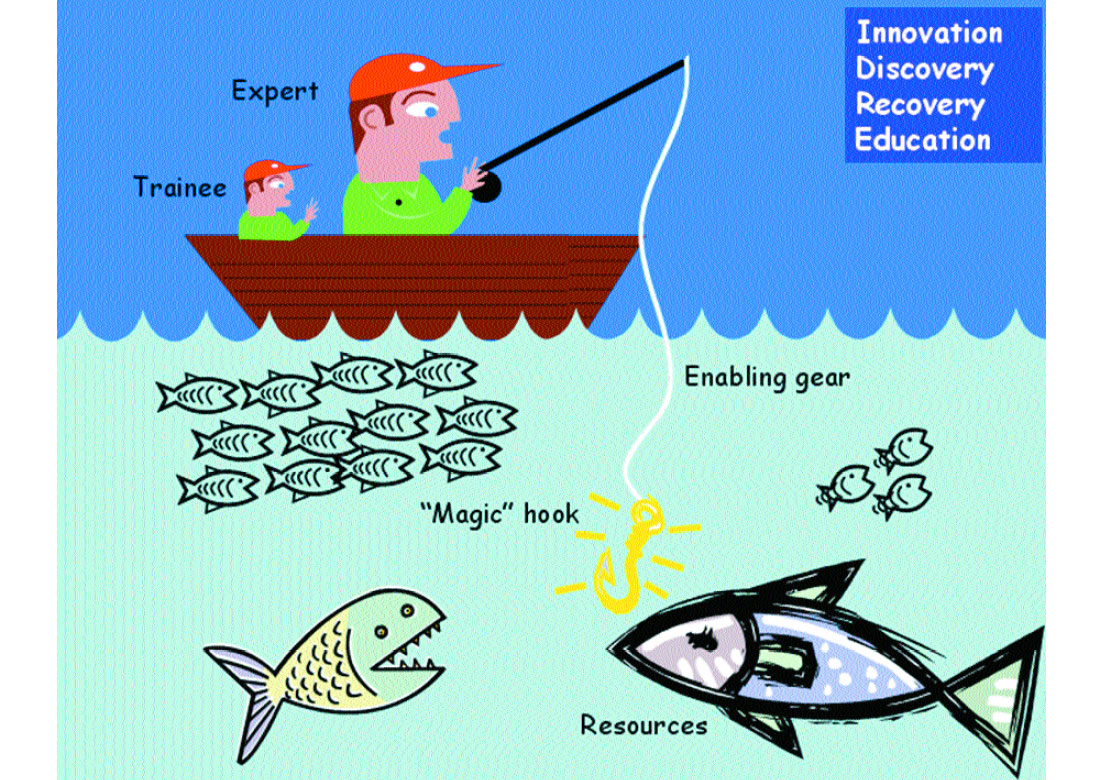
University-industry relationships
The industry and the university can be associated in a number of ways. These relationships might range from the informal, small, and short-term to the contractual, broad, and multi-year as follows:
- Guest lectures, continuing education courses
- Consultancies, spin-off companies
- Sabbaticals (both ways)
- Adjunct professorships
- Senate, Advisory Boards
- Informal joint projects
- Donations
- Research contracts
- Consortia
All of these arrangements can provide benefit to both parties. In this paper though, we will discuss mainly the consortium structure. We can define, “consortium” as:
- A cooperative arrangement among groups (www.thefreedictionary.com)
- An association or combination of institutions or businesses for the purpose of engaging in a joint venture
- An agreement, combination, or group formed to undertake an enterprise beyond the resources of any one member (www.merriam-webster.com/dictionary)
The university-industry consortium structure is similarly based on an understanding or agreement among participants and will likely involve a formal contract. However, the consortium has some advantages over a specific contract between researchers and a single company. For example, the consortium’s work can potentially be distributed to a larger audience with the possibility of greater impact. In addition, the sponsoring companies’ fees can be smaller and pooled which lowers risk. Also, untoward changes in a single company's fortunes or personnel are less likely to be fatal for the whole consortium. Furthermore, there can be more and varied opportunities for interaction and output. On the other hand, research results from the consortium will be provided to all of its sponsors (and often eventually made public), so there may be less competitive advantage accruing to a particular company. And communications with a group of sponsors may be more complex than with a single company.
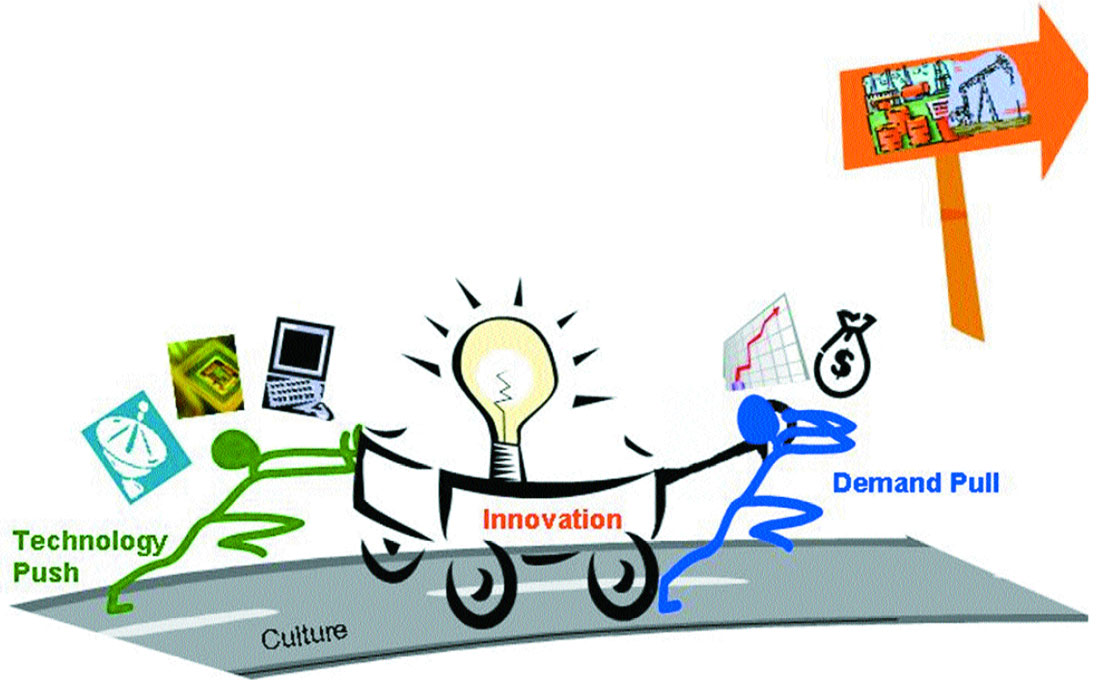
Making the consortium work is assisted by a number of factors. These can include having certain natural advantages in location, personnel, or local industries. There must be faculty leadership, significant industry interest, and university or government support. The consortium’s research may often involve new, but unproven high-potential technology. Innovation in the energy industry is associated with some factors that are not under its control – advancements in other fields as well as resource demand (Figure 3). So, researchers must stay alert to breakthroughs elsewhere, in addition to being somewhat lucky with the concurrent price of hydrocarbons. Ultimately, the consortium must deliver results including significant ideas, reports, perhaps software and data, and a steady supply of enthusiastic and capable graduates. Other aspects of a program which can encourage success are:
- A critical mass of researchers (that is, a team of full-time professors, staff scientists, and visitors).
- Strong undergraduate and graduate program and students – B.Sc., M.Sc., Ph.D.
- Up-to-date equipment and software.
- Long-term administration, hardware, and software support staff.
- Requisite office, lecture, and lab space.
- Track records of excellence in research and ongoing development of highly qualified personnel (HQP).
- Regular contact with sponsors and consistent deliverables.
- Supply of industry data, projects, internships.
- Intense involvement in professional societies.
- Visibility (media, publications, meetings, courses).
The geophysics community
As mentioned above, the chances of achieving a successful partnership will be increased if certain factors are present. Clearly, having the university and industry in close proximity for meetings and courses, with similar laws and language, and informal sharing of expertise is of considerable benefit. In the specific CREWES (Consortium for Research in Elastic Wave Exploration Seismology) case, the city of Calgary provides an excellent home for a geophysics consortium because of the strength, breadth and capabilities of its geophysics community. The Canadian Society of Exploration Geophysicists (CSEG) and Canadian Society of Petroleum Geologists (CSPG) are headquartered in the city. APEGGA has a local office and the Tulsa-based Society of Exploration Geophysicists (SEG) has had four Presidents from Calgary (Larson, 2005). There are hundreds of energy companies, numerous seismic contractors, consultants and service companies located in the city. Thus, Calgary is a vibrant centre of geophysics and one of the top geoscience cities in the world, with hundreds of professional geophysicists.
Being close to an industry centre provides a natural job market for undergraduate and graduate students as well as staff. The ongoing interplay of education and employment greatly supports the continuity required by the consortium. Students are a critical link between the university and industry – it may be that newly graduated students are the best form of “technology transfer”. Having a strong university is deeply beneficial to a city as it attracts, educates, and can help keep expertise in its proximity as well as provide numerous other economic multipliers.
There is also a reverse mechanism that transfers people and expertise from the industry to the university consortium. A flourishing consortium can provide an attractive second career for industrial scientists who, feeling they have made their mark in industry, are looking for a chance to use their substantial skill and knowledge in other ways. After a nominal retirement from industry, many talented scientists have joined CREWES and derived satisfaction from involvement in more fundamental research and for the opportunity of mentoring of the next generation of geoscientists. This mechanism benefits the broader geophysical community by bringing those with the accumulated wisdom into direct contact with those in training.
The CREWES consortium
The mandate of the CREWES Project is to conduct advanced research and education in geophysical exploration in partnership with the resource industry. The Project is specifically committed to developing seismic methods to understand, image, and monitor the subsurface and its fluids. While the Project maintains a traditional structure of professors and their individual graduate students, stable consortium revenue enables the critical addition of support staff in administration, research, and technical roles (Figure 4).

The Project is established inside the university with funding largely from outside of it (Figure 5). With CREWES, the majority of the funding is from industrial sponsors (some 30 companies engaged in petroleum exploration, including national oil companies, super-majors, independents, seismic contractors, and software companies) who pay an annual sponsorship fee. This fee is renewable annually. While this is short-term for the University and provides annual stress, it makes a lower risk investment for the industry and encourages timely production. CREWES also receives significant funding from the federal government, under a Collaborative Research and Development (CRD) grant from the Natural Sciences and Engineering Research Council (NSERC). The grant provides monies that match a portion of those contributed by the industry. We believe that this matching protocol is wise on the government’s part as it lets the technologies’ actual users (or market) regularly indicate if the research is valuable. It is noteworthy that some consortia in other countries, unfortunately, do not receive such government matching support.

The full CREWES group (Figure 6) consists of some 50 individuals including six geophysics professors in the Department of Geoscience, and a professor in the Department of Mathematics and Statistics, at the University of Calgary, their associated graduate students (approximately 35), and twelve staff members. The group meets once a week to receive a technical presentation from its ranks and/or visitors. Students help realize CREWES goals as well as undertake their graduate M.Sc. and Ph.D. programs. The Project and university provide many opportunities for students including interesting classes and courses; research involvement with excellent support staff, facilities, and data; and participation in meetings and conferences via presentation and publications. Reciprocally, the Project expects CREWES students to undertake conscientious research in geophysical problems, achieve creative and useful results, and strive for professional development and respectful deportment.
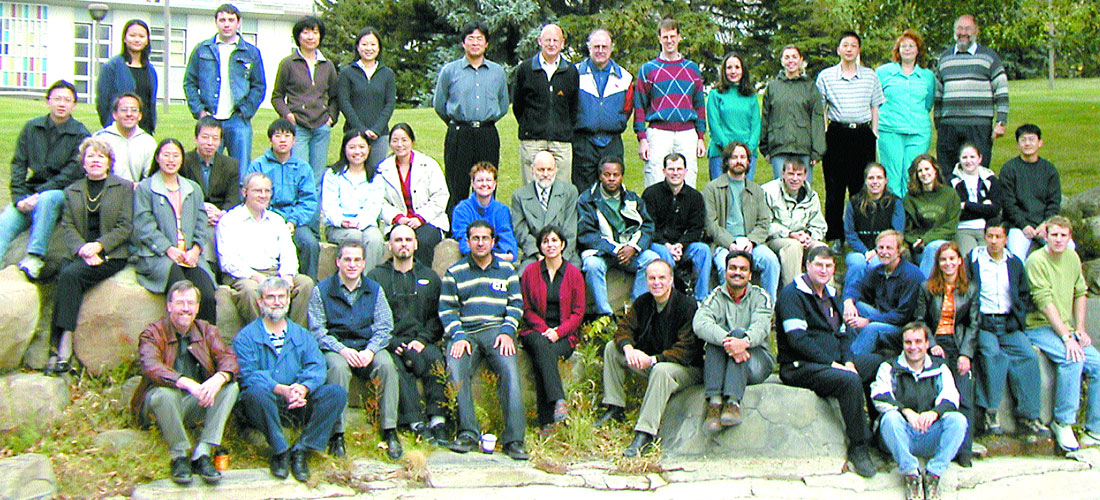
The Project’s personnel are heavily involved in our professional organizations (CSEG, SEG, APEGGA, Australian SEG, EAGE (European Association of Engineers and Geoscientists) and SIAM (Society of Industrial and Applied Mathematics). This is essential for student and staff development, nurturing of our science and profession, and awareness of geophysical advancements.
A key aspect in the forging of a partnership between industry and the university is the delivery of results. Annually, CREWES sponsors receive research reports, software, data, and an invitation to the Sponsors Meeting (typically attended by more than 60 geophysicists from around the world). The meeting gives representatives from sponsoring companies the chance to attend presentations describing recent research results, update their technical skills at courses taught by faculty, interact with senior researchers, and meet the next generation of geophysicists (CREWES has graduated some 100 Ph.D.’s and M.Sc.’s, most of whom were subsequently employed by sponsoring companies). A list of contributions from CREWES to its sponsors (the “deliverables”) is given in Appendix I.
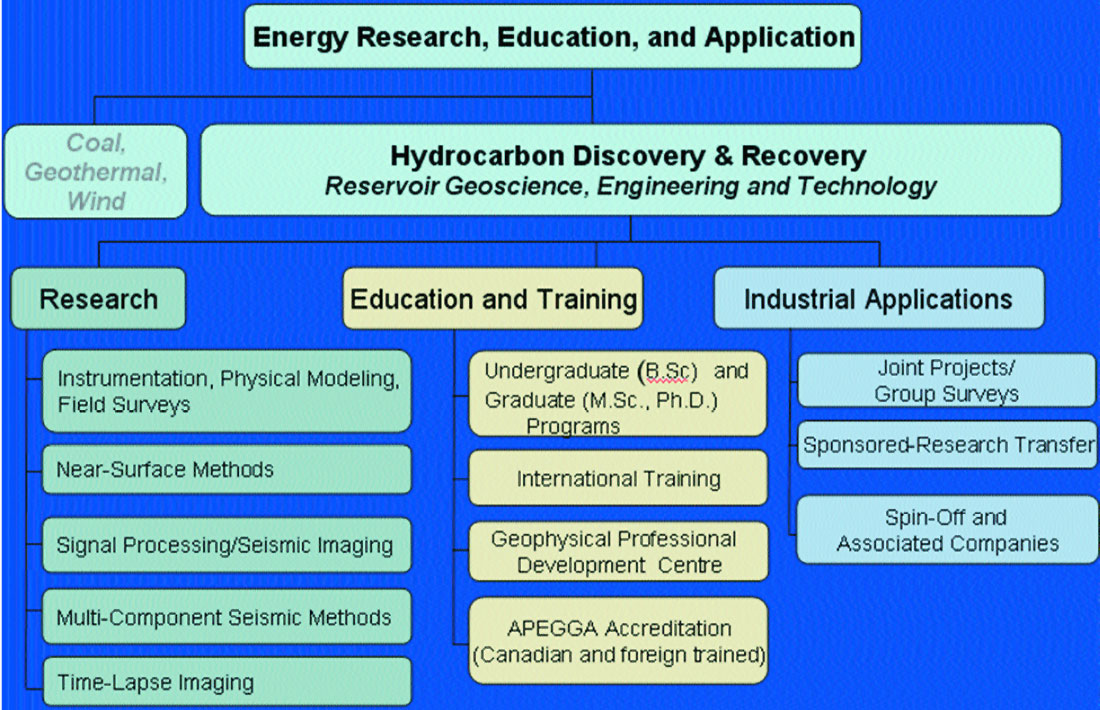
CREWES has been involved in international development and outreach projects (Figure 7). Examples include technology transfers to ONGC (The Indian national oil company), Petrobras, and Aramco and some associated universities. CREWES faculty led the effort to set up Thailand’s first graduate school in geophysics. Currently, CREWES non confidential research results (data, software, reports and teaching materials) are distributed publicly via the SEG and through the Project website (www.crewes.org).
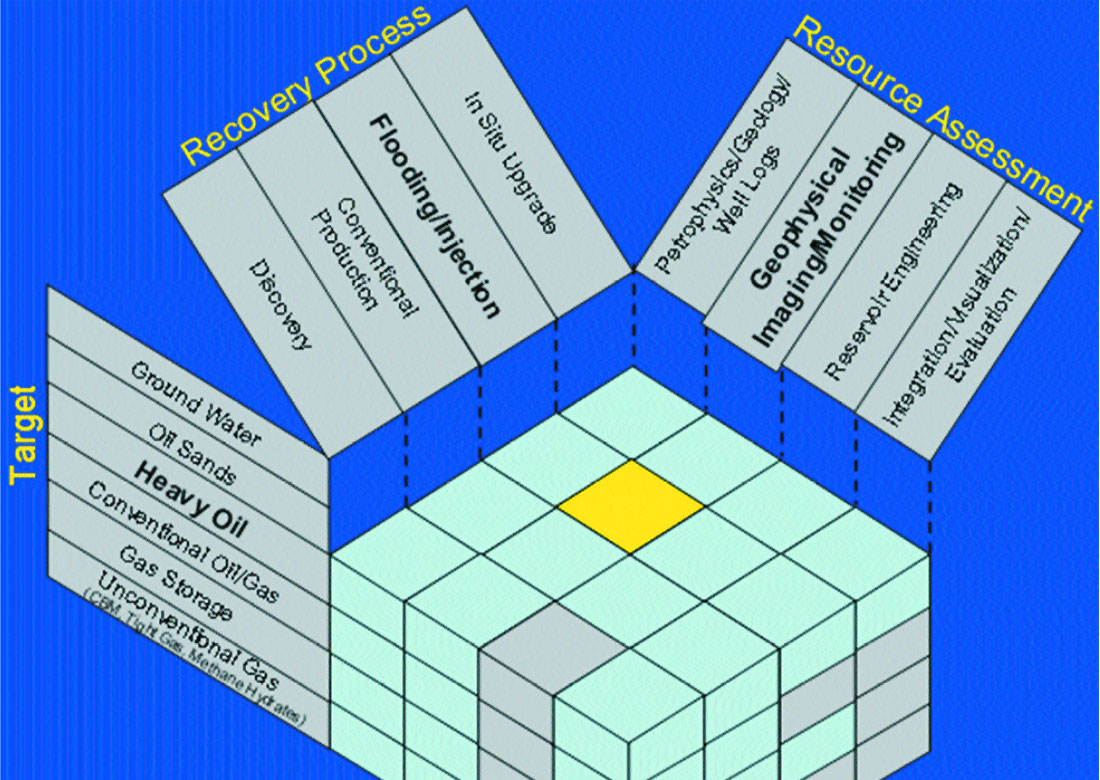
More specifically, CREWES is involved in understanding the geology and petrophysics of resource targets while developing characterization, recovery, and monitoring methods associated with the resources (Figure 8).
In further detail, the technical goals of the Project are to:
- Provide better structural images of the subsurface.
- Determine lithologic information (rock type).
- Describe rock properties (porosity, fractures, permeability).
- Estimate fluid content.
- Monitor reservoir changes.
- Help find & recover underground resources.
- Design & test geophysical instruments.
- Enhance the acquisition of field and lab data.
- Investigate the mathematics of wave propagation & imaging.
- Advance computer programming, modeling and data processing methods.
- Undertake wellbore (logs & VSP) geophysics.
- Interpret geophysical data & synthesize case histories.
Progress Assessment
It is important to review the accomplishments of any ongoing program. We attempt to do this in CREWES via a number of indicators. One simple indicator is sponsorship renewal itself. However, we find that this may be more tied to the state of the industry (merger and acquisition activity and the price of commodities) than our productivity. So, we have developed another indicator composed of awards, publications, surveys, data, student graduations, and software released. This output number attempts to capture a sense of the Project’s productivity and impact. We’ve plotted this indicator versus time in Figure 9.

overall increase over the years and so has output. But, we might ask, “how has output per person or per dollar fared?” Is bigger, better? We find that the output per dollar of support and per person has been fairly constant (Figure 10).
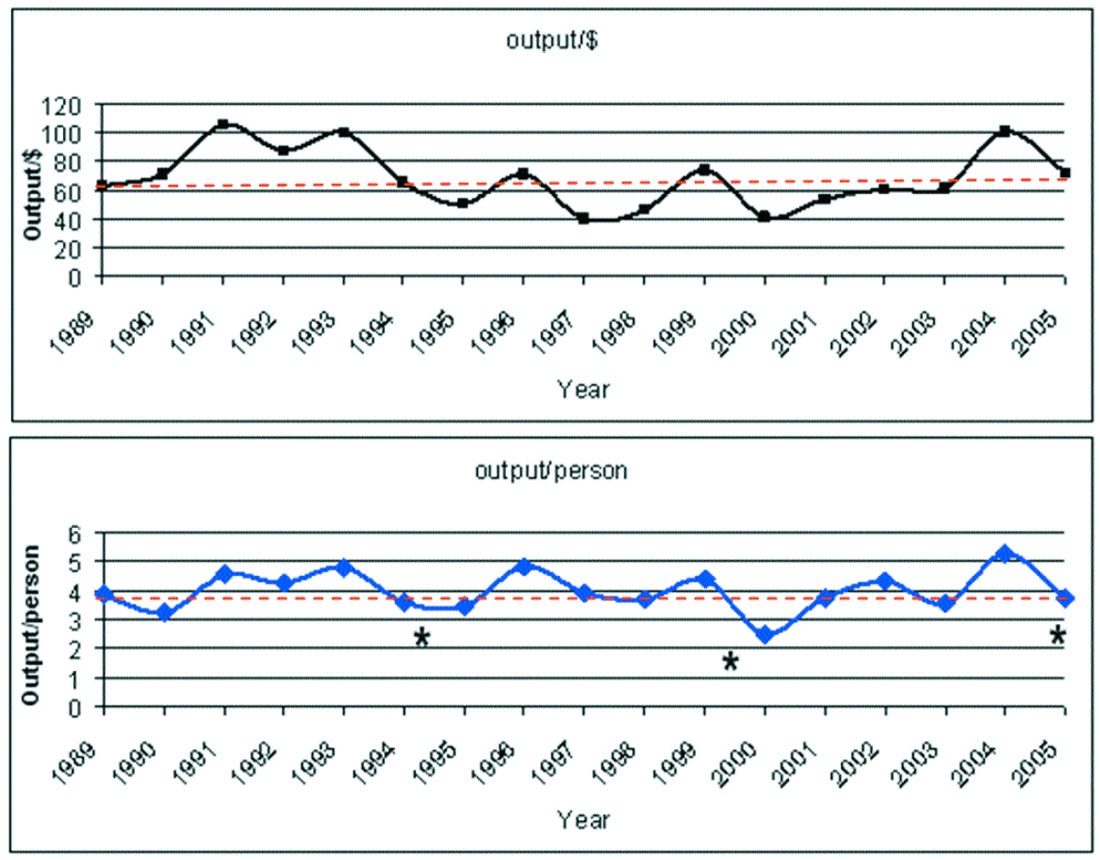
So, output/person has been largely independent of the Project’s total number of personnel. Thus, bigger is not better on a per person basis; but, neither is smaller. However, total output has increased substantially. So, in general, it’s likely better to have a larger project with greater output which could provide a better chance of some research results having a major impact.
We can also try to use outside statistics to assess the impact of CREWES. The number of citations by other authors is one indicator of impact. Figure 11 shows a citation index from one database and suggests that CREWES’ impact is increasing and of similar value to other consortia.
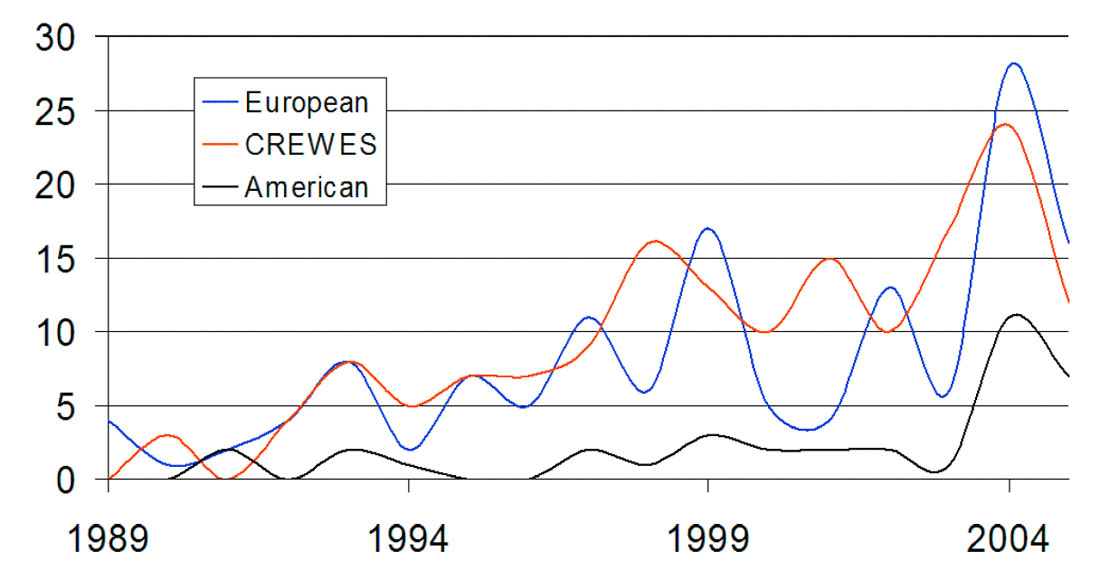
Challenges
There are certainly some challenges presented by the creation of a consortium. Naturally, the financial supporters must receive some clear benefit from their funding. This requires considerable time, on the part of university faculty and staff, to organize and deliver results. Part of the specific industry benefit comes from having access to information that is not immediately available otherwise. This precipitates confidentiality requirements. CREWES research documents remain restricted to sponsors for a period (two years). This does not include theses, abstracts, journal papers and their derivative material (however, the Project does strive to provide abstracts to the sponsorship first, then release them to the public). On the industry’s part, its support will often be maximized through greater involvement of its personnel (e.g., in joint projects, internships, technology tests). This will take some time and resource commitment from the company as well as its representatives and CREWES personnel. A consortium necessarily operates as a team. Some personnel may be less inclined to work closely with others, so expectations need to be presented clearly and managed.
Some critics of industry-university relationships have suggested that the university could be compromised in its objective pursuit of knowledge as a result of industry contact. Or that the university could be overly influenced by sponsorship demands. We can say that this has not been our experience in the last 20 years. The sponsorship members are generally good scientists in their own right, quite deferential to university goals and constraints, and are seeking inspired results somewhat different from their own internal work or that of service companies. More over, the research environment in applied geoscience at the University of Calgary has been very positively impacted by the existence of CREWES and the resultant influx of industry support.
Conclusions
The industry and university have much to gain by working collaboratively. Our field of geophysics, the education of students, and the application of technology to pressing problems can all be improved by a university-industry partnership. The CREWES Project aspires to make better pictures of the subsurface via advanced seismic methods. Success in this undertaking is enhanced by the natural advantages of a local industry, numerous associated professionals, and a dedicated staff and faculty. Using these advantages can give rise to a consistently productive group in applied geophysics.

Acknowledgements
The authors would like to thank NSERC (Natural Sciences and Engineering Research Council of Canada) and all CREWES sponsors. We also express our deep appreciation to the many students and staff of the CREWES Project who have taught us so much.
Appendix I – Deliverables
Each sponsor of the CREWES Project:
- has immediate access to the CREWES Research Collection (in 2008 consisting of 876 research reports and 89 student graduate theses from the last 20 years), software, and CREWES News through the web site (www.crewes.org).
- receives the yearly, bound Research Report on CREWES research activities ( approximately 70 chapters and 900 pages) and bi-monthly CREWES Newsletter;
- receives regular releases of software developed by the Project;
- has access to detailed seismic field surveys acquired by the Project including a 3C- 3D survey and a broad-band set of 3-C lines from the Blackfoot field near Strathmore, Alberta, a high-resolution 3-C survey, a vertical hydrophone cable line, and a 3C-3D near-surface survey.
- has access to physical modelling data (acoustic and elastic);
- is invited to continuing education courses on areas of recent technical development;
- is invited to the annual Sponsors Meeting where CREWES-generated research results are presented;
- receives graduate-student theses, presentation abstracts, and publication reprints;
- receives copies of lecture notes and CREWES-authored SEG publications as well as Power Point presentations
- has the opportunity to develop joint projects of mutual interest; and xi) has a chance to become acquainted with graduate students as potential future employees.










Join the Conversation
Interested in starting, or contributing to a conversation about an article or issue of the RECORDER? Join our CSEG LinkedIn Group.
Share This Article